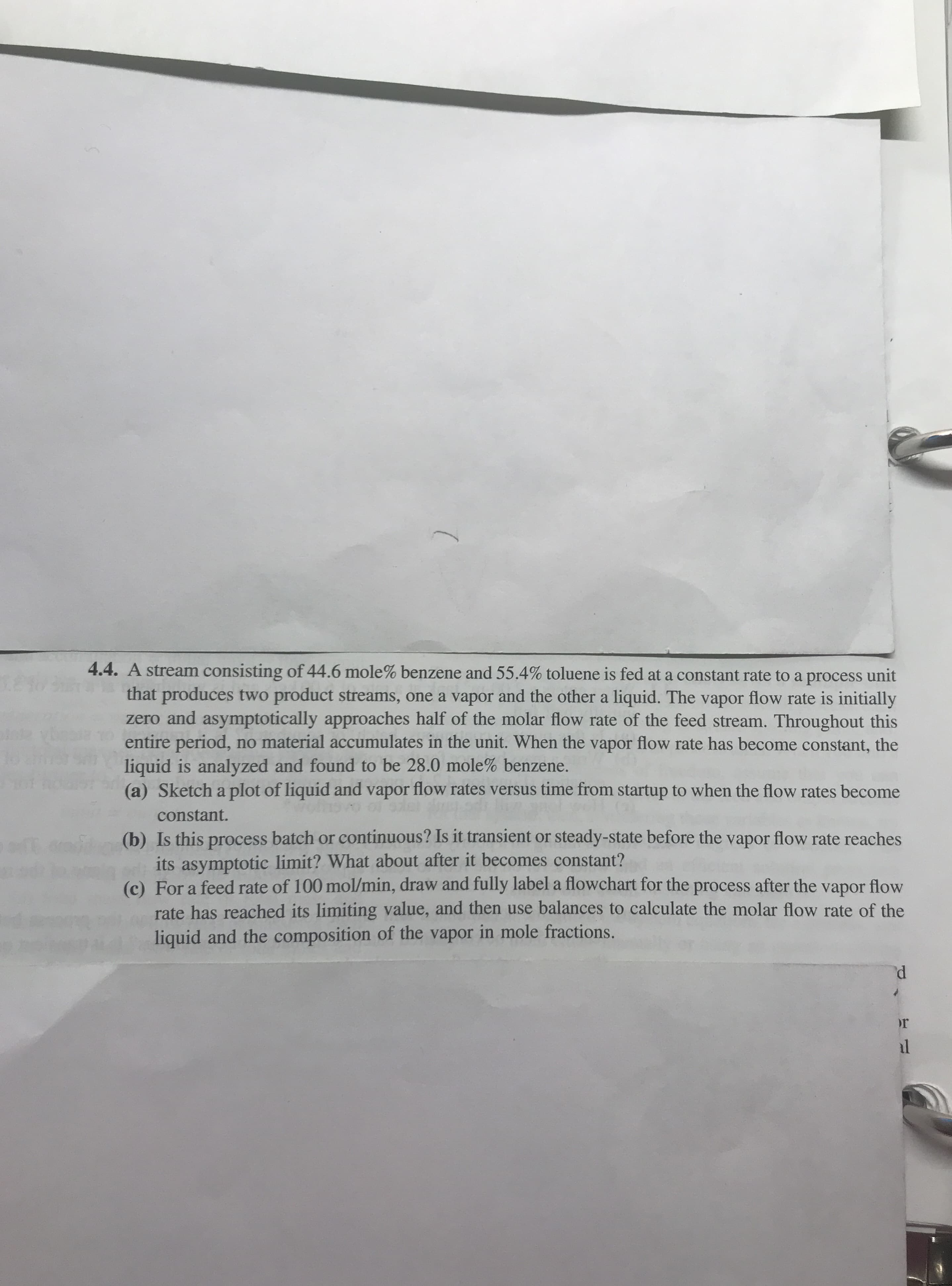4.4. A stream consisting of 44.6 mole% benzene and 55.4% toluene is fed at a constant rate to a process unit that produces two product streams, one a vapor and the other a liquid. The vapor flow rate is initially zero and asymptotically approaches half of the molar flow rate of the feed stream. Throughout this entire period, no material accumulates in the unit. When the vapor flow rate has become constant, the liquid is analyzed and found to be 28.0 mole% benzene. (a) Sketch a plot of liquid and vapor flow rates versus time from startup to when the flow rates become constant. (b) Is this process batch or continuous? Is it transient or steady-state before the vapor flow rate reaches its asymptotic limit? What about after it becomes constant? (c) For a feed rate of 100 mol/min, draw and fully label a flowchart for the process after the vapor flow rate has reached its limiting value, and then use balances to calculate the molar flow rate of the liquid and the composition of the vapor in mole fractions.
4.4. A stream consisting of 44.6 mole% benzene and 55.4% toluene is fed at a constant rate to a process unit that produces two product streams, one a vapor and the other a liquid. The vapor flow rate is initially zero and asymptotically approaches half of the molar flow rate of the feed stream. Throughout this entire period, no material accumulates in the unit. When the vapor flow rate has become constant, the liquid is analyzed and found to be 28.0 mole% benzene. (a) Sketch a plot of liquid and vapor flow rates versus time from startup to when the flow rates become constant. (b) Is this process batch or continuous? Is it transient or steady-state before the vapor flow rate reaches its asymptotic limit? What about after it becomes constant? (c) For a feed rate of 100 mol/min, draw and fully label a flowchart for the process after the vapor flow rate has reached its limiting value, and then use balances to calculate the molar flow rate of the liquid and the composition of the vapor in mole fractions.
Introduction to Chemical Engineering Thermodynamics
8th Edition
ISBN:9781259696527
Author:J.M. Smith Termodinamica en ingenieria quimica, Hendrick C Van Ness, Michael Abbott, Mark Swihart
Publisher:J.M. Smith Termodinamica en ingenieria quimica, Hendrick C Van Ness, Michael Abbott, Mark Swihart
Chapter1: Introduction
Section: Chapter Questions
Problem 1.1P
Related questions
Question
100%

Transcribed Image Text:4.4. A stream consisting of 44.6 mole% benzene and 55.4% toluene is fed at a constant rate to a process unit
that produces two product streams, one a vapor and the other a liquid. The vapor flow rate is initially
zero and asymptotically approaches half of the molar flow rate of the feed stream. Throughout this
entire period, no material accumulates in the unit. When the vapor flow rate has become constant, the
liquid is analyzed and found to be 28.0 mole% benzene.
(a) Sketch a plot of liquid and vapor flow rates versus time from startup to when the flow rates become
constant.
(b) Is this process batch or continuous? Is it transient or steady-state before the vapor flow rate reaches
its asymptotic limit? What about after it becomes constant?
(c) For a feed rate of 100 mol/min, draw and fully label a flowchart for the process after the vapor flow
rate has reached its limiting value, and then use balances to calculate the molar flow rate of the
liquid and the composition of the vapor in mole fractions.
Expert Solution
This question has been solved!
Explore an expertly crafted, step-by-step solution for a thorough understanding of key concepts.
This is a popular solution!
Trending now
This is a popular solution!
Step by step
Solved in 6 steps with 4 images

Recommended textbooks for you

Introduction to Chemical Engineering Thermodynami…
Chemical Engineering
ISBN:
9781259696527
Author:
J.M. Smith Termodinamica en ingenieria quimica, Hendrick C Van Ness, Michael Abbott, Mark Swihart
Publisher:
McGraw-Hill Education

Elementary Principles of Chemical Processes, Bind…
Chemical Engineering
ISBN:
9781118431221
Author:
Richard M. Felder, Ronald W. Rousseau, Lisa G. Bullard
Publisher:
WILEY

Elements of Chemical Reaction Engineering (5th Ed…
Chemical Engineering
ISBN:
9780133887518
Author:
H. Scott Fogler
Publisher:
Prentice Hall

Introduction to Chemical Engineering Thermodynami…
Chemical Engineering
ISBN:
9781259696527
Author:
J.M. Smith Termodinamica en ingenieria quimica, Hendrick C Van Ness, Michael Abbott, Mark Swihart
Publisher:
McGraw-Hill Education

Elementary Principles of Chemical Processes, Bind…
Chemical Engineering
ISBN:
9781118431221
Author:
Richard M. Felder, Ronald W. Rousseau, Lisa G. Bullard
Publisher:
WILEY

Elements of Chemical Reaction Engineering (5th Ed…
Chemical Engineering
ISBN:
9780133887518
Author:
H. Scott Fogler
Publisher:
Prentice Hall


Industrial Plastics: Theory and Applications
Chemical Engineering
ISBN:
9781285061238
Author:
Lokensgard, Erik
Publisher:
Delmar Cengage Learning

Unit Operations of Chemical Engineering
Chemical Engineering
ISBN:
9780072848236
Author:
Warren McCabe, Julian C. Smith, Peter Harriott
Publisher:
McGraw-Hill Companies, The